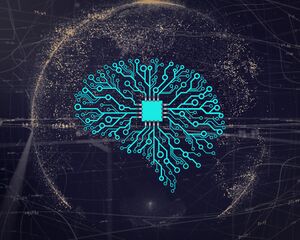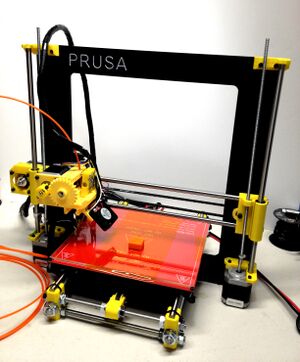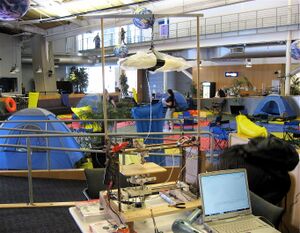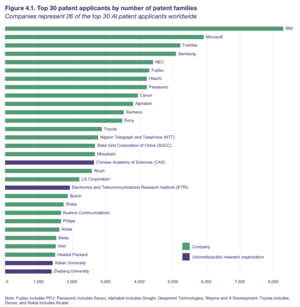التقنيات الناشئة
| تاريخ التكنولوجيا |
|---|
| ما بعد الإنسانية |
|---|
 |
| مفاهيم في ما بعد الإنسانية |
| فئات جزئية مما بعد الإنسانية |
| الأيديولوجيات السياسية |
التقنيات الناشئة Emerging technologies هي technologies whose development, practical applications, or both are still largely unrealized, such that they are figuratively emerging into prominence from a background of nonexistence or obscurity. These technologies are generally new but also include older technologies. Emerging technologies are often perceived as capable of changing the status quo.
Emerging technologies are characterized by radical novelty (in application even if not in origins), relatively fast growth, coherence, prominent impact, and uncertainty and ambiguity. In other words, an emerging technology can be defined as "a radically novel and relatively fast growing technology characterised by a certain degree of coherence persisting over time and with the potential to exert a considerable impact on the socio-economic domain(s) which is observed in terms of the composition of actors, institutions and patterns of interactions among those, along with the associated knowledge production processes. Its most prominent impact, however, lies in the future and so in the emergence phase is still somewhat uncertain and ambiguous."[1]
Emerging technologies include a variety of technologies such as educational technology, information technology, nanotechnology, biotechnology, robotics, and artificial intelligence.[note 1]
New technological fields may result from the technological convergence of different systems evolving towards similar goals. Convergence brings previously separate technologies such as voice (and telephony features), data (and productivity applications) and video together so that they share resources and interact with each other, creating new efficiencies.
Emerging technologies are those technical innovations which represent progressive developments within a field for competitive advantage;[2] converging technologies represent previously distinct fields which are in some way moving towards stronger inter-connection and similar goals. However, the opinion on the degree of the impact, status and economic viability of several emerging and converging technologies varies.
تاريخ التقنيات الناشئة
In the history of technology, emerging technologies[3][4] are contemporary advances and innovation in various fields of technology.
Over centuries innovative methods and new technologies are developed and opened up. Some of these technologies are due to theoretical research, and others from commercial research and development.
Technological growth includes incremental developments and disruptive technologies. An example of the former was the gradual roll-out of DVD (digital video disc) as a development intended to follow on from the previous optical technology compact disc. By contrast, disruptive technologies are those where a new method replaces the previous technology and makes it redundant, for example, the replacement of horse-drawn carriages by automobiles and other vehicles.
مناظرات التقنيات الناشئة
Many writers, including computer scientist Bill Joy,[5] have identified clusters of technologies that they consider critical to humanity's future. Joy warns that the technology could be used by elites for good or evil. They could use it as "good shepherds" for the rest of humanity or decide everyone else is superfluous and push for mass extinction of those made unnecessary by technology.[6]
Advocates of the benefits of technological change typically see emerging and converging technologies as offering hope for the betterment of the human condition. Cyberphilosophers Alexander Bard and Jan Söderqvist argue in The Futurica Trilogy that while Man himself is basically constant throughout human history (genes change very slowly), all relevant change is rather a direct or indirect result of technological innovation (memes change very fast) since new ideas always emanate from technology use and not the other way around.[7] Man should consequently be regarded as history's main constant and technology as its main variable. However, critics of the risks of technological change, and even some advocates such as transhumanist philosopher Nick Bostrom, warn that some of these technologies could pose dangers, perhaps even contribute to the extinction of humanity itself; i.e., some of them could involve existential risks.[8][9]
Much ethical debate centers on issues of distributive justice in allocating access to beneficial forms of technology. Some thinkers, including environmental ethicist Bill McKibben, oppose the continuing development of advanced technology partly out of fear that its benefits will be distributed unequally in ways that could worsen the plight of the poor.[10] By contrast, inventor Ray Kurzweil is among techno-utopians who believe that emerging and converging technologies could and will eliminate poverty and abolish suffering.[11]
Some analysts such as Martin Ford, author of The Lights in the Tunnel: Automation, Accelerating Technology and the Economy of the Future,[12] argue that as information technology advances, robots and other forms of automation will ultimately result in significant unemployment as machines and software begin to match and exceed the capability of workers to perform most routine jobs.
As robotics and artificial intelligence develop further, even many skilled jobs may be threatened. Technologies such as machine learning[13] may ultimately allow computers to do many knowledge-based jobs that require significant education. This may result in substantial unemployment at all skill levels, stagnant or falling wages for most workers, and increased concentration of income and wealth as the owners of capital capture an ever-larger fraction of the economy. This in turn could lead to depressed consumer spending and economic growth as the bulk of the population lacks sufficient discretionary income to purchase the products and services produced by the economy.[14]
|
التقنيات الناشئة |
|
|
|
|
|
|
|
|
أمثلة من التقنيات الناشئة
الذكاء الاصطناعي (AI) is the sub intelligence exhibited by machines or software, and the branch of computer science that develops machines and software with animal-like intelligence. Major AI researchers and textbooks define the field as "the study and design of intelligent agents," where an intelligent agent is a system that perceives its environment and takes actions that maximize its chances of success. John McCarthy, who coined the term in 1956, defines it as "the study of making intelligent machines".
The central functions (or goals) of AI research include reasoning, knowledge, planning, learning, natural language processing (communication), perception and the ability to move and manipulate objects. General intelligence (or "strong AI") is still among the field's long-term goals. Currently, popular approaches include deep learning, statistical methods, computational intelligence and traditional symbolic AI. There is an enormous number of tools used in AI, including versions of search and mathematical optimization, logic, methods based on probability and economics, and many others.
3D printing, also known as additive manufacturing, has been posited by Jeremy Rifkin and others as part of the third industrial revolution.[17]
Combined with Internet technology, 3D printing would allow for digital blueprints of virtually any material product to be sent instantly to another person to be produced on the spot, making purchasing a product online almost instantaneous.
Although this technology is still too crude to produce most products, it is rapidly developing and created a controversy in 2013 around the issue of 3D printed guns.[18]
العلاج الجيني
Gene therapy was first successfully demonstrated in late 1990/early 1991 for adenosine deaminase deficiency, though the treatment was somatic – that is, did not affect the patient's germ line and thus was not heritable. This led the way to treatments for other genetic diseases and increased interest in germ line gene therapy – therapy affecting the gametes and descendants of patients.
Between September 1990 and January 2014, there were around 2,000 gene therapy trials conducted or approved.[19]
لقاحات السرطان
A cancer vaccine is a vaccine that treats existing cancer or prevents the development of cancer in certain high-risk individuals. Vaccines that treat existing cancer are known as therapeutic cancer vaccines. There are currently no vaccines able to prevent cancer in general.
On April 14, 2009, The Dendreon Corporation announced that their Phase III clinical trial of Provenge, a cancer vaccine designed to treat prostate cancer, had demonstrated an increase in survival. It received U.S. Food and Drug Administration (FDA) approval for use in the treatment of advanced prostate cancer patients on April 29, 2010.[20] The approval of Provenge has stimulated interest in this type of therapy.[21]
اللحم المستنبت
Cultured meat, also called in vitro meat, clean meat, cruelty-free meat, shmeat, and test-tube meat, is an animal-flesh product that has never been part of a living animal with exception of the fetal calf serum taken from a slaughtered cow. In the 21st century, several research projects have worked on in vitro meat in the laboratory.[22] The first in vitro beefburger, created by a Dutch team, was eaten at a demonstration for the press in London in August 2013.[23] There remain difficulties to be overcome before in vitro meat becomes commercially available.[24] Cultured meat is prohibitively expensive, but it is expected that the cost could be reduced to compete with that of conventionally obtained meat as technology improves.[25][26] In vitro meat is also an ethical issue. Some argue that it is less objectionable than traditionally obtained meat because it doesn't involve killing and reduces the risk of animal cruelty, while others disagree with eating meat that has not developed naturally.[بحاجة لمصدر]
تكنولوجيا النانو
Nanotechnology (sometimes shortened to nanotech) is the manipulation of matter on an atomic, molecular, and supramolecular scale. The earliest widespread description of nanotechnology[27][28] referred to the particular technological goal of precisely manipulating atoms and molecules for fabrication of macroscale products, also now referred to as molecular nanotechnology. A more generalized description of nanotechnology was subsequently established by the National Nanotechnology Initiative, which defines nanotechnology as the manipulation of matter with at least one dimension sized from 1 to 100 nanometers. This definition reflects the fact that quantum mechanical effects are important at this quantum-realm scale, and so the definition shifted from a particular technological goal to a research category inclusive of all types of research and technologies that deal with the special properties of matter that occur below the given size threshold.
الروبوتات
Robotics is the branch of technology that deals with the design, construction, operation, and application of robots,[29] as well as computer systems for their control, sensory feedback, and information processing. These technologies deal with automated machines that can take the place of humans in dangerous environments or manufacturing processes, or resemble humans in appearance, behavior, and/or cognition. A good example of a robot that resembles humans is Sophia, a social humanoid robot developed by Hong Kong-based company Hanson Robotics which was activated on April 19, 2015. Many of today's robots are inspired by nature contributing to the field of bio-inspired robotics.
العلاج بالخلايا الجذعية
Stem cell therapy is an intervention strategy that introduces new adult stem cells into damaged tissue in order to treat disease or injury. Many medical researchers believe that stem cell treatments have the potential to change the face of human disease and alleviate suffering.[30] The ability of stem cells to self-renew and give rise to subsequent generations with variable degrees of differentiation capacities[31] offers significant potential for generation of tissues that can potentially replace diseased and damaged areas in the body, with minimal risk of rejection and side effects.
Chimeric antigen receptor (CAR)-modified T cells have raised among other immunotherapies for cancer treatment, being implemented against B-cell malignancies. Despite the promising outcomes of this innovative technology, CAR-T cells are not exempt from limitations that must yet to be overcome in order to provide reliable and more efficient treatments against other types of cancer.[32]
Distributed ledger technology
Distributed ledger or blockchain technology provides a transparent and immutable list of transactions. A wide range of uses has been proposed for where an open, decentralised database is required, ranging from supply chains to العملات المشفرة.
Smart contracts are self-executing transactions which occur when pre-defined conditions are met. The aim is to provide security that is superior to traditional contract law, and to reduce transaction costs and delays. The original idea was conceived by Nick Szabo in 1994,[33] but remained unrealised until the development of blockchains.[34][35]
تطوير التقنيات الناشئة
As innovation drives economic growth, and large economic rewards come from new inventions, a great deal of resources (funding and effort) go into the development of emerging technologies. Some of the sources of these resources are described below...
الأبحاث والتطوير
Research and development is directed towards the advancement of technology in general, and therefore includes development of emerging technologies. See also List of countries by research and development spending.
Applied research is a form of systematic inquiry involving the practical application of science. It accesses and uses some part of the research communities' (the academia's) accumulated theories, knowledge, methods, and techniques, for a specific, often state-, business-, or client-driven purpose.
Science policy is the area of public policy which is concerned with the policies that affect the conduct of the science and research enterprise, including the funding of science, often in pursuance of other national policy goals such as technological innovation to promote commercial product development, weapons development, health care and environmental monitoring.
براءات الاختراع
Patents provide inventors with a limited period of time (minimum of 20 years, but duration based on jurisdiction) of exclusive right in the making, selling, use, leasing or otherwise of their novel technological inventions. Artificial intelligence, robotic inventions, new material, or blockchain platforms may be patentable, the patent protecting the technological know-how used to create these inventions.[36] In 2019, WIPO reported that AI was the most prolific emerging technology in terms of number of patent applications and granted patents, the Internet of things was estimated to be the largest in terms of market size. It was followed, again in market size, by big data technologies, robotics, AI, 3D printing and the fifth generation of mobile services (5G).[37] Since AI emerged in the 1950s, 340000 AI-related patent applications were filed by innovators and 1.6 million scientific papers have been published by researchers, with the majority of all AI-related patent filings published since 2013. Companies represent 26 out of the top 30 AI patent applicants, with universities or public research organizations accounting for the remaining four.[38]
دارپا
The Defense Advanced Research Projects Agency (DARPA) is an agency of the U.S. Department of Defense responsible for the development of emerging technologies for use by the military.
DARPA was created in 1958 as the Advanced Research Projects Agency (ARPA) by President Dwight D. Eisenhower. Its purpose was to formulate and execute research and development projects to expand the frontiers of technology and science, with the aim to reach beyond immediate military requirements.
Projects funded by DARPA have provided significant technologies that influenced many non-military fields, such as the Internet and Global Positioning System technology.
مسابقات وجوائز التكنولوجيا
There are awards that provide incentive to push the limits of technology (generally synonymous with emerging technologies). Note that while some of these awards reward achievement after-the-fact via analysis of the merits of technological breakthroughs, others provide incentive via competitions for awards offered for goals yet to be achieved.
The Orteig Prize was a $25,000 award offered in 1919 by French hotelier Raymond Orteig for the first nonstop flight between New York City and Paris. In 1927, underdog Charles Lindbergh won the prize in a modified single-engine Ryan aircraft called the Spirit of St. Louis. In total, nine teams spent $400,000 in pursuit of the Orteig Prize.
The XPRIZE series of awards, public competitions designed and managed by the non-profit organization called the X Prize Foundation, are intended to encourage technological development that could benefit mankind. The most high-profile XPRIZE to date was the $10,000,000 Ansari XPRIZE relating to spacecraft development, which was awarded in 2004 for the development of SpaceShipOne.
The Turing Award is an annual prize given by the Association for Computing Machinery (ACM) to "an individual selected for contributions of a technical nature made to the computing community." It is stipulated that the contributions should be of lasting and major technical importance to the computer field. The Turing Award is generally recognized as the highest distinction in computer science, and in 2014 grew to $1,000,000.
The Millennium Technology Prize is awarded once every two years by Technology Academy Finland, an independent fund established by Finnish industry and the Finnish state in partnership. The first recipient was Tim Berners-Lee, inventor of the World Wide Web.
In 2003, David Gobel seed-funded the Methuselah Mouse Prize (Mprize) to encourage the development of new life extension therapies in mice, which are genetically similar to humans. So far, three Mouse Prizes have been awarded: one for breaking longevity records to Dr. Andrzej Bartke of Southern Illinois University; one for late-onset rejuvenation strategies to Dr. Stephen Spindler of the University of California; and one to Dr. Z. Dave Sharp for his work with the pharmaceutical rapamycin.
دور الخيال العلمي
Science fiction has often affected innovation and new technology - for example many rocketry pioneers were inspired by science fiction[39] - and the documentary How William Shatner Changed the World gives a number of examples of imagined technologies being actualized.
في الإعلام
The term bleeding edge has been used to refer to some new technologies, formed as an allusion to the similar terms "leading edge" and "cutting edge". It tends to imply even greater advancement, albeit at an increased risk because of the unreliability of the software or hardware.[40] The first documented example of this term being used dates to early 1983, when an unnamed banking executive was quoted to have used it in reference to Storage Technology Corporation.[41]
انظر أيضاً
- List of emerging technologies
- Foresight
- Futures studies
- Future of Humanity Institute
- Institute for Ethics and Emerging Technologies
- Institute on Biotechnology and the Human Future
- Technological change
- Transhumanism
- Upcoming software
ملاحظات
المراجع
- Citations
- ^ Rotolo, Daniele; Hicks, Diana; Martin, Ben R. (December 2015). "What is an emerging technology?" (PDF). Research Policy. 44 (10): 1827–1843. doi:10.1016/j.respol.2015.06.006. S2CID 15234961. SSRN 2564094.
- ^ International Congress Innovation and Technology XXI: Strategies and Policies Towards the XXI Century, & Soares, O. D. D. (1997). Innovation and technology: Strategies and policies. Dordrecht: Kluwer Academic.[صفحة مطلوبة]
- ^ Emerging Technologies: From Hindsight to Foresight. Edited by Edna F. Einsiedel. UBC Press.
- ^ Emerging technologies: where is the federal government on the high tech curve? : hearing before the Subcommittee on Government Management, Information, and Technology of the Committee on Government Reform, House of Representatives, One Hundred Sixth Congress, second session, April 24, 2000
- ^ See: Wired Magazine, "Why the future doesn't need us",
- ^ Joy, Bill (2000). "Why the future doesn't need us". Wired. Retrieved 2005-11-14.
- ^ Bard, Alexander; Söderqvist, Jan (8 May 2012). The Futurica Trilogy. Stockholm Text. ISBN 978-9187173240.
- ^ Bostrom, Nick (2002). "Existential risks: analyzing human extinction scenarios". Retrieved 2006-02-21.
{{cite journal}}: Cite journal requires|journal=(help) - ^ Warwick, K: “March of the Machines”, University of Illinois Press, 2004
- ^ McKibben, Bill (2003). Enough: Staying Human in an Engineered Age. Times Books. ISBN 978-0-8050-7096-5.
- ^ Kurzweil, Raymond (2005). The Singularity Is Near: When Humans Transcend Biology. Viking Adult. ISBN 978-0-670-03384-3.
- ^ قالب:Ford 2009 The lights in the tunnel
- ^ econfuture (14 April 2011). "Machine Learning: A job killer?". Retrieved 28 May 2017.
- ^ Saenz, Aaron (15 December 2009). "Martin Ford Asks: Will Automation Lead to Economic Collapse?". Retrieved 28 May 2017.
- ^ Circuit boards began development in 1960s. An example, among others, includes Stacked Printed Circuit Board by Victor F. Dahlgren et al. U.S. Patent 3٬409٬732. See also: System in Package (SiP) or Chip Stack MCM
- ^ This conceptual drawing measures in diameter 200+ m (660 ft.+).
- ^ "Home – Office of Jeremy Rifkin". Office of Jeremy Rifkin. Archived from the original on 25 February 2017. Retrieved 28 May 2017.
- ^ Estes, Adam Clark. "3D-Printed Guns Are Only Getting Better, and Scarier". Retrieved 28 May 2017.
- ^ "Gene Therapy Clinical Trials Worldwide". www.wiley.com. Retrieved 28 May 2017.
- ^ "Approval Letter – Provenge". Food and Drug Administration. 2010-04-29. Archived from the original on 2017-07-23.
- ^ "What Comes After Dendreon's Provenge?". 18 Oct 2010. Archived from the original on 2016-08-14.
- ^ Siegelbaum, D.J. (2008-04-23). "In Search of a Test-Tube Hamburger". Time. Archived from the original on January 22, 2010. Retrieved 2009-04-30.
- ^ "World's first lab-grown burger is eaten in London". BBC News. 5 August 2013. Retrieved 28 May 2017.
- ^ Fountain, Henry (12 May 2013). "Engineering the $325,000 In Vitro Burger". The New York Times. Retrieved 28 May 2017.
- ^ Temple, James (2009-02-23). "The Future of Food: The No-kill Carnivore". Portfolio.com. Retrieved 2009-08-07.
- ^ Preliminary Economics Study of Cultured Meat Archived أكتوبر 3, 2015 at the Wayback Machine, eXmoor Pharma Concepts, 2008
- ^ Drexler, K. Eric (1986). Engines of Creation: The Coming Era of Nanotechnology. Doubleday. ISBN 978-0-385-19973-5.
- ^ Drexler, K. Eric (1992). Nanosystems: Molecular Machinery, Manufacturing, and Computation. New York: John Wiley & Sons. ISBN 978-0-471-57547-4.
- ^ "robotics". Oxford Dictionaries. Retrieved 4 February 2011.
- ^ Lindvall, O.; Kokaia, Z. (2006). "Stem cells for the treatment of neurological disorders". Nature. 441 (7097): 1094–1096. Bibcode:2006Natur.441.1094L. doi:10.1038/nature04960. PMID 16810245. S2CID 4425363.
- ^ Weissman IL (January 2000). "Stem cells: units of development, units of regeneration, and units in evolution". Cell. 100 (1): 157–68. doi:10.1016/S0092-8674(00)81692-X. PMID 10647940. S2CID 12414450. as cited in Gurtner GC; Callaghan MJ; Longaker MT (2007). "Progress and potential for regenerative medicine". Annu. Rev. Med. 58: 299–312. doi:10.1146/annurev.med.58.082405.095329. PMID 17076602.
- ^ Ureña-Bailén, Guillermo; Lamsfus-Calle, Andrés; Daniel-Moreno, Alberto; Raju, Janani; Schlegel, Patrick; Seitz, Christian; Atar, Daniel; Antony, Justin S; Handgretinger, Rupert; Mezger, Markus (20 May 2020). "CRISPR/Cas9 technology: towards a new generation of improved CAR-T cells for anticancer therapies". Briefings in Functional Genomics. 19 (3): 191–200. doi:10.1093/bfgp/elz039. PMID 31844895.
- ^ "Nick Szabo -- Smart Contracts: Building Blocks for Digital Markets". www.fon.hum.uva.nl. Retrieved 2018-03-08.
- ^ How blockchain technology could change our lives - European Parliamentary Research Service
- ^ Vincenzo, Morabito (2017). Business Innovation Through Blockchain: The B3 Perspective. pp. 101–124.
- ^ S. Cadogan, Marsha. "Relationships, Issues Around Intellectual Property, Emerging Technologies".
- ^ "Intellectual Property and Frontier Technologies". WIPO.
- ^ "WIPO Technology Trends 2019 - Artificial Intelligence" (PDF). WIPO. 2019.
- ^ Benson, Michael (20 July 2019). "Science Fiction Sent Man to the Moon". Retrieved 11 August 2019.
- ^ Ingo Schommer; Steven Broschart (2010). SilverStripe: The Complete Guide to CMS Development. John Wiley & Sons. p. 22. ISBN 978-0-470-68270-8.
- ^ Hayes, Thomas C. (21 March 1983). "Hope at Storage Technology". The New York Times. Retrieved 10 September 2013.
للاستزادة
- عام
- Giersch, H. (1982). Emerging technologies: Consequences for economic growth, structural change, and employment : symposium 1981. Tübingen: Mohr.
- Jones-Garmil, K. (1997). The wired museum: Emerging technology and changing paradigms. Washington, DC: American Association of Museums.
- Kaldis, Byron (2010). "Converging Technologies". Sage Encyclopedia of Nanotechnology and Society, Thousand Oaks: CA, Sage
- Rotolo D.; Hicks D.; Martin B. R. (2015). "What is an emerging technology?". Research Policy. 44 (10): 1827–1843. arXiv:1503.00673. doi:10.1016/j.respol.2015.06.006. S2CID 15234961.
- القانون والسياسات
- Branscomb, L. M. (1993). Empowering technology: Implementing a U.S. strategy. Cambridge, Mass: MIT Press.
- Raysman, R., & Raysman, R. (2002). Emerging technologies and the law: Forms and analysis. Commercial law intellectual property series. New York, N.Y.: Law Journal Press.
- المعلومات والتعلم
- Hung, D., & Khine, M. S. (2006). Engaged learning with emerging technologies. Dordrecht: Springer.
- Kendall, K. E. (1999). Emerging information technologies: Improving decisions, cooperation, and infrastructure. Thousand Oaks, Calif: Sage Publications.
- المصوّر
- Weinersmith, Kelly; Weinersmith, Zach (2017). Soonish: Ten Emerging Technologies That'll Improve and/or Ruin Everything. Penguin Press. ISBN 978-0399563829.
- غيرهم
- Cavin, R. K., & Liu, W. (1996). Emerging technologies: Designing low power digital systems. [New York]: Institute of Electrical and Electronics Engineers.
- مقالات بالمعرفة بحاجة لذكر رقم الصفحة بالمصدر from July 2021
- Short description is different from Wikidata
- Articles with hatnote templates targeting a nonexistent page
- Articles with unsourced statements from February 2014
- Missing redirects
- Pages with empty portal template
- Emerging technologies
- Bioethics
- Transhumanism
- Technology development


![3D IC components. Master and the slave boards.[15]](/w/images/thumb/2/25/3DS_die_stacking_concept_model.PNG/120px-3DS_die_stacking_concept_model.PNG)




![Atmo-vortex engines.[16] Vortex generators](/w/images/thumb/8/8c/Conceptual_vortex_engine.jpg/116px-Conceptual_vortex_engine.jpg)






